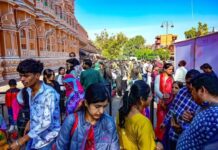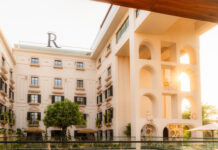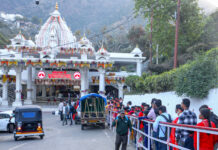 Set against the backdrop of the dramatic Dhauladhar mountains, Dharamsala is perched on the high slopes in the upper reaches of Kangra Valley. The town is divided into two distinct and widely separated sections, Upper and Lower Dharamsala, which differ almost a thousand meters in height.
Set against the backdrop of the dramatic Dhauladhar mountains, Dharamsala is perched on the high slopes in the upper reaches of Kangra Valley. The town is divided into two distinct and widely separated sections, Upper and Lower Dharamsala, which differ almost a thousand meters in height.
Dharamsala has become synonymous with the Tibetan government in exile and the home of Tibetan leader Dalai Lama. Even if the Tibetan community dominates the town, it has still retained the colonial lifestyle and British fervor.
Dharamsala overlooks the plains and is surrounded by dense pine trees and Deodar forests. A nearby snowline with numerous streams and cool healthy atmosphere makes the surrounding very attractive.
Dharamsala is a busy bazaar town and has established itself as the travelers’ base camp, who come to explore the nearby mountains. The Kotwali Bazaar provides the entire color and characteristic of a small town, which is mixed with simple lifestyle.
The colorful temple and Gompas which reflect the culture of Tibet add attraction for the visitor. The Kangra museum gives an overview of the rich past of the region. There are institutes that have been established to preserve Tibetan art, cultures and traditions.
Attractions:
St. John’s Church in Wilderness: 7-km upward from Dharamsala, between Forsyth Ganj and Mcleod Ganj lies the charming St. John’s Church. It was built in 1852 and is dressed in grey stone with some fine Belgian stained glass windows donated by Lady Elgin. The church is popularly known as the church of St. John in Wilderness.
Chamunda Devi Temple: Mere 15-km from Dharamsala in a tiny village of Dadh on Palampur Road is the famous temple dedicated to Goddess Chamunda Devi. It is an enchanting spot with glorious views of the mountains, the Baner Khud, Pathiar and Lahla forests.
Maharana Pratap Sagar: Named in honor of the great patriot ‘Maharana Pratap’ (1572 – 97 AD), the Maharana Pratap Sagar was once known as the ‘Pong Dam Reservoir’. India knows the ‘Maharana’ as a man who struggled valiantly for his kingdom of ‘Mewar’ for the principle of independence. In the words of the Chroniclers James Tod and William Crooke, “He spurned every overture that had submission for its basis”. Over the river Beas, the “Pong Dam” was completed in 1976. Its reservoir has an area of about 45,0000 hectares at maximum possible flooding – the level varies with every season and averages around 30,000 hectares. Over 2,000 villages with a population of over 85, people are lying along the wetland.
The Wildlife Sanctuary: In 1983, Maharana Pratap Sagar was declared a wildlife sanctuary and over 220 species of bird belonging to 54 families have been sighted over the waters and the fringing mud-banks. These include black-headed gulls, plovers, terns, ducks, water-fowl and egrets. The first sighting in the region of the red-necked grebe was made at the Sagar.
The wetland’s location at the head of the Indian plains has made it a suitable habitat and stopover for migratory birds that enter India from Central Asia. The land portion of the sanctuary has barking deer, sambar, wild boars, nilgai, leopards and clawless otters. Twenty-seven species and sub-species of fish belonging to six families have been recorded in the Sagar’s waters. Some of the important commercial varieties are – Labeo dero (Gid), Labeo rohita, Labeo Calbasu, Tor putitora (Mahsir), and Mystus seenghala (Singhara). Since 1976, fishing has been a major economic activity in the areas and today it provides employment to some 1,500 fishermen and the annual catch is valued at over a crore of rupees.
Norbulinka Institute: Just 4-kms from Dharamsala is Norbulinka. This place has heavy Japanese influence. The Norbulingka Institute of Tibetan Culture was founded by the Department of Religion and Culture to preserve and promote Tibetan art and culture in exile
Nurpur Fort: Originally known as Dhameri, 66-km from Dharamsala and 24-km from Pathankot, Nurpur Fort was renamed by Emperor Jehangir, son of the Great Moghul Jalal-Ud-Din Mohammad Akbar. The fort is now in ruins but still has some finely carved reliefs.
 Tsug-Lag-Khang (Central Cathedral): Though a plain and utilitarian substitute for its far more splendid namesake in Lhasa, also known as the Jokhang, the Tsug-Lag-Khang is nevertheless fascinating and peaceful. Situated opposite the residence of His Holiness the Dalai Lama, Tsug-Lag-Khang is known to local Indians as the Main Temple.
Tsug-Lag-Khang (Central Cathedral): Though a plain and utilitarian substitute for its far more splendid namesake in Lhasa, also known as the Jokhang, the Tsug-Lag-Khang is nevertheless fascinating and peaceful. Situated opposite the residence of His Holiness the Dalai Lama, Tsug-Lag-Khang is known to local Indians as the Main Temple.
Andretta: Situated just 13-kms away from Palampur lies this dwelling place of artist S. Sobha Singh. It houses a gallery of some of his major works and a pottery center.
Dall Lake: Surrounded by high and green Deodar trees is the lake, which fills a mountain bowl. Situated 11-kms away from the town, this lake is easily approachable by road and makes an enchanting and serene picnic spot.
Dharmkot: Just 11-km away from Dharamsala, located on the crest of a hill lies this attractive picnic spot, which presents a panoramic view of the Kangra Valley and Dauladhar ranges
Kunal Pathri: These are the rock temples from which the place derives its name. Kunal Pathri is a 3 kms flat walk from Kotwali Bazaar.
Best Time to visit: Mid-May to Mid-October.
How to Get There:
Air: Dharamsala can be approached by air from Delhi and the nearest Airport is at Gaggla, just 13-km away from the town.
Rail: Pathankot is 85-km and is the nearest railhead for Dharamsala. Trains from all over the country make a stop over at Pathankot and from here it is a three-hour journey to Dharamsala.
Road: From Manali bus services are available to this place. One can drive from Delhi via Chandigarh, Kiratpur, Bilaspur and it’s an eight-hour journey. From Delhi and Shimla, luxury buses ply to Dharamsala.






